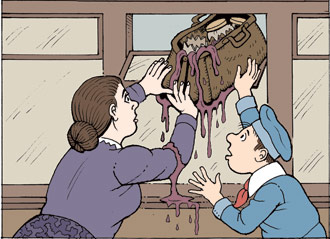This Sunday we bid Don Draper and the rest of the Mad Men characters a final farewell. The question on everyone’s mind: Will Don ride off into the sunset or will he fall to his death and reunite with Bert Cooper in the big ad agency in the sky?
Many have opined on whether the animated opening title sequence, in which the silhouette of a man plummets from a skyscraper, represents a literal or metaphorical window into Don Draper’s future. Beyond that soon to be settled matter/question, has Matthew Weiner been trying to tell us something with the show’s opening title music all these years?
Weiner originally wanted Beck to write the music. Beck declined, though, betting that a show about 1960s ad executives would be a bore. Weiner later chose RJD2’s “A Beautiful Mine” after he stumbled on the song while listening to public radio. I suspect that Weiner wanted from Beck something similar to what he ended up with: a delicious collage of pop postmodernity. And while the RJD2’s music wasn’t created for Mad Men, it was scrupulously cut from its original length of 5 minutes, 29 seconds to just 37 seconds. It has a “big old movie quality to it, and updated beat to it, it had drama,” Weiner has said. “I just loved it.”
In Weiner’s hands, the song has become a paean to change and uncertainty. The drum pattern alone distinctly changes three separate times during the title sequence. But in that short time, we get a fascinating glimpse of the distant past, the recent past, and possibly even the future.
The track opens with the main theme played by dark strings with only the simplest percussion, a scarcely audible high hat. The image is clear: Sinatra-era pop, heyday 1950s. At nine seconds in, the theme’s simple cadence is surprisingly destroyed by the sound (and image) of the floor dropping out from underneath. A vigorous drum fill shakes us from our postwar American slumber, and yields to the second main segment, which is pure Technicolor modernity.
The strings repeat the theme, now to an upbeat drum pattern that is almost mamboesque. Onscreen, we watch the silhouetted man fall through time and space—and get a kick in the tail from a giant woman’s foot. White male hegemony gives way to feminism, civil rights, diversity—progress.
A languid harp at 22 seconds plucks out a snaky line as the man’s fall gathers speed and impact becomes imminent. The line is ambiguous, neither completely decorative nor distinctly thematic. Does it represent lingering memories of yesteryear or, perhaps, a harbinger of eternal rest?
Suddenly, the chaos evaporates. Did the man somehow survive the fall? We find him resting comfortably on a couch, tending to a cigarette (Lucky Strike, no doubt). A new, crisp, square drum pattern replaces the previously busy texture. Is it the present day? Did Draper live long enough to be able to look back on his pinnacle days? Or was this fall simply an anxiety dream?
As the sequence closes, the theme nearly resolves. But the clean cadence is sullied. Distant horns sound at 34 seconds, evoking Weiner’s beloved New York of yore. They are like taxicab horns bouncing off the skyscrapers and they are pitched just a few cents shy of the minor seventh—one of the most emotionally ambiguous of all intervals in music. Weiner seems to want us to know: Don’s outcome has yet to be written. Or at least, until now, he has refused to reveal it to us.
















